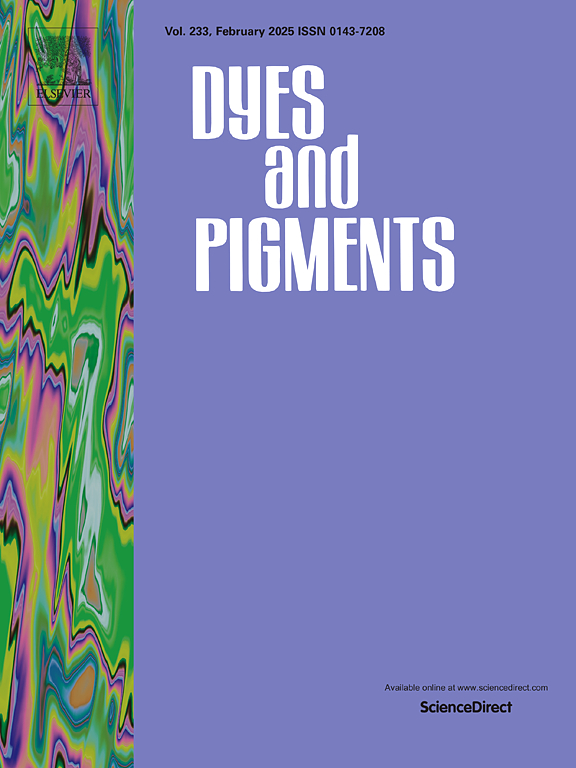Rational design of a red-emitting AIE-ESIPT probe for real-time visualization of lipid droplet dynamics in metabolic stress and ferroptosis
IF 4.1
3区 工程技术
Q2 CHEMISTRY, APPLIED
引用次数: 0
Abstract
Lipid droplets (LDs), central to lipid homeostasis and implicated in metabolic disorders, cancer, and neurodegenerative diseases, urgently require advanced imaging probes to overcome limitations of conventional tools—such as small Stokes shifts, low photostability, and complex washing steps. To address these challenges, we engineered three ESIPT-active fluorescent probes (HBT-CF3, Al-HBT-CF3, In-HBT-CF3) through systematic molecular design. By progressively integrating stronger electron-withdrawing groups into the HBT scaffold, we achieved In-HBT-CF3, a red-emitting probe (λem: 620 nm) with a 8038 cm−1 Stokes shift, 41 % quantum yield, and negligible phototoxicity. Its performance stems from synergistic action between restricted intramolecular rotation and hydrophobic shielding, which reinforce intramolecular hydrogen bonds and suppress non-radiative decay. Demonstrating rapid (<2 min), wash-free LD labeling, In-HBT-CF3 enabled real-time tracking of LD dynamics under metabolic stress (starvation/oleic acid) and during ferroptosis, revealing erastin-induced LD accumulation and Fer-1-mediated suppression. This work not only resolves critical drawbacks of existing probes but also establishes a design framework for next-generation imaging tools, advancing mechanistic studies of LD-related pathologies and oxidative stress-driven diseases.

合理设计用于代谢应激和铁下垂中脂滴动态实时可视化的红色发射AIE-ESIPT探针
脂滴(ld)是脂质稳态的核心,与代谢紊乱、癌症和神经退行性疾病有关,迫切需要先进的成像探针来克服传统工具的局限性,如小斯托克斯位移、低光稳定性和复杂的洗涤步骤。为了解决这些挑战,我们通过系统的分子设计设计了三种esipt活性荧光探针(hpt - cf3, al - hpt - cf3, in - hpt - cf3)。通过逐步将更强的吸电子基团整合到HBT支架中,我们获得了In-HBT-CF3,这是一种红发探针(λem: 620 nm), Stokes位移为8038 cm−1,量子产率为41%,光毒性可忽略不计。其性能源于受限制的分子内旋转和疏水屏蔽的协同作用,增强了分子内氢键,抑制了非辐射衰变。In-HBT-CF3显示出快速(2分钟),免洗LD标记,能够实时跟踪代谢应激(饥饿/油酸)和铁死亡期间LD动态,揭示erastin诱导的LD积累和fe -1介导的抑制。这项工作不仅解决了现有探针的关键缺陷,而且为下一代成像工具建立了设计框架,推进了ld相关病理和氧化应激驱动疾病的机制研究。
本文章由计算机程序翻译,如有差异,请以英文原文为准。
求助全文
约1分钟内获得全文
求助全文
来源期刊

Dyes and Pigments
工程技术-材料科学:纺织
CiteScore
8.20
自引率
13.30%
发文量
933
审稿时长
33 days
期刊介绍:
Dyes and Pigments covers the scientific and technical aspects of the chemistry and physics of dyes, pigments and their intermediates. Emphasis is placed on the properties of the colouring matters themselves rather than on their applications or the system in which they may be applied.
Thus the journal accepts research and review papers on the synthesis of dyes, pigments and intermediates, their physical or chemical properties, e.g. spectroscopic, surface, solution or solid state characteristics, the physical aspects of their preparation, e.g. precipitation, nucleation and growth, crystal formation, liquid crystalline characteristics, their photochemical, ecological or biological properties and the relationship between colour and chemical constitution. However, papers are considered which deal with the more fundamental aspects of colourant application and of the interactions of colourants with substrates or media.
The journal will interest a wide variety of workers in a range of disciplines whose work involves dyes, pigments and their intermediates, and provides a platform for investigators with common interests but diverse fields of activity such as cosmetics, reprographics, dye and pigment synthesis, medical research, polymers, etc.
 求助内容:
求助内容: 应助结果提醒方式:
应助结果提醒方式:


